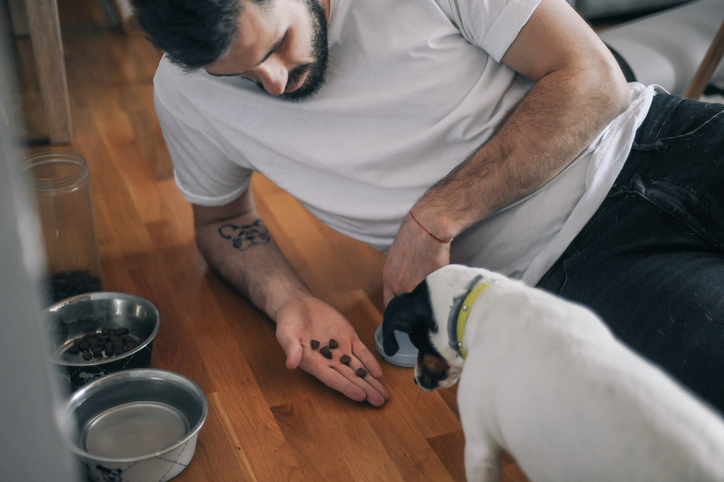The future of pet parenthood is happening now
Pet humanization isn’t a new fad. It’s a longstanding, enduring trend that is a recognized growth driver of thriving markets for pet foods, products and services.
Pet humanization intertwines with trends for higher pet adoption, better human nutrition and fitness, and environmental sustainability.
Home but not alone
According to a McKinsey report, the pandemic accelerated existing trends in remote working and virtual meetings—and these trends are likely to continue at reduced levels in the post-pandemic economy.
Greater flexibility in work schedules and locations means a key barrier to pet ownership—lack of time to care for and engage with pets—has been dramatically reduced. Working remotely, online shopping, telemedicine—these all result in people spending more time at home, driving pet adoption. People working from home found pets to be a great replacement for the loss of person-to-person interactions at a central office.
Last May, an American Society of Prevention of Cruelty to Animals survey found that approximately 23 million American households had acquired a cat or dog during the pandemic. That’s about one of every five households. The adoptions are sticking: ASPCA said 90 percent of dog adopters and 85 percent of cat adopters were not considering rehoming their new pets.
Millennials see pets as their first-born children.
Since the pandemic began, American workers have found more time for enjoying pets and bonding with them, and more economic ability to sustain them. With less travel to a central workplace, they are spending less on gas, repairs, and ultimately, a new vehicle.
Looking at what has happened in the last two years, we’re gaining terrific insights into the future of having pets in the household. We’re seeing that future unfold now.
And it’s not just because of forces unleashed by the pandemic. Demographic forces are hard at work, too, on the future of having pets. Richard Kestenbaum wrote in Forbes, “As Millennial and Generation Z consumers have come into adulthood, they have embraced the pet-owning and pet-loving lifestyles to a far greater extent than their elders.”
Millennials are now the largest living generation. They are the major target for marketers of pet products and services—for good reasons:
- A 2020 survey by YPulse found that 76% of Millennials prefer to have pets over children.
- Millennials comprise 35 percent of the workforce. Their careers consume their time and attention. So, it’s logical for them to temporarily forego having children when they can get unconditional love and loyalty from their pets.
- Millennials are careful food shoppers. They value ingredient transparency. They read food labels closely, often buy organic foods, and are willing to spend money on high-quality foods. These tendencies carry over into how they shop for pet foods.
From feeding time to fun time, innovation is everywhere.
Soaring pet adoption has translated into another trend: remarkable innovation in pet products and services. Visit any pet store, and you’ll find the shelves packed with a plethora of wet, dry, frozen, and freeze-dried foods addressing a wide range of pet needs. You’ll see “scientific” formulations for a pet’s specific life stage and “natural” formulations with whole food ingredients rather than the fractionated ingredients of heavily processed foods. In addition, you’ll see foods, medications, and dietary supplements to support healthy fur, digestive systems, kidneys, hips, and joints.
Even grocery stores have expanded the space devoted to pet products. They now stock premium brands in multiple formulations next to the conventional value brands.
Pet parents expect more from pet foods than just healthy ingredients. They want foods that offer solutions to health issues and increase companionship. Because they have more time at home to be with their pets, pet parents are turning the daily feeding times into engagement opportunities in a way that we’ve never seen before. In essence, “engagement” means the human is getting just as much out of the feeding experience as the pet.
The same observation extends to other pet products and services, from treats to insurance. Millennial and Generation Z households deem a wide variety of items as essential expenditures rather than impulsive spending. Pet product companies have responded with huge varieties of chews, puzzles, and other toys to entertain pets and their owners.
The future of pets in the household—based on mutually rewarding experiences for pet parents and their pets—is happening now. The experiences can encompass foods, treats, games, grooming, boarding, and more. We’re also seeing innovation in the area of palliative services for terminally ill pets, as well as pet cemeteries and memorials for beloved pets that have passed away.
Cited sources:
“The Future of Work after COVID-19,” McKinsey Global Institute, February 18, 2021
“New ASPCA Survey Shows Overwhelming Majority of Dogs and Cats Acquired During the Pandemic Are Still in Their Homes,” ASPCA news release, May 26, 2021
“The Biggest Trends in the Pet Industry,” Richard Kestenbaum, Forbes, November 27, 2018
“Millennials on Parenthood: 10 Reasons Why Millennials Opt For Pets,” Kara Page, topdogtips.com, October 22, 2021
